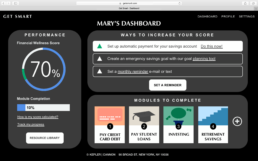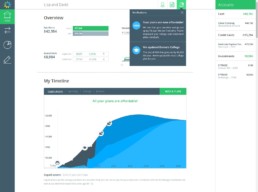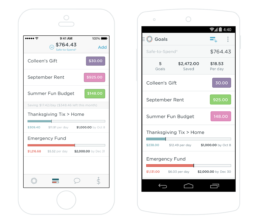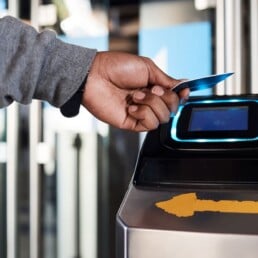The Evolving Digital Paradigm
WHAT CUSTOMERS WANT
It is no secret that ‘getting Digital right’ is going to be critical for wealth managers to succeed. By 2020, half of all enterprise revenue will be driven by digital channels; it is projected that more than 60% of consumers will be tech-savvy “digital natives” who grew up online and on their smartphones.[1] Across industries, many firms have made significant strides to improving their digital experience. In the realm of financial services, the retail banking industry has been at the forefront of these changes. The 2017 American Customer Satisfaction Index (ASCI) report indicated a 1.3 percent climb in customer satisfaction of retail banks (to 81 points), with digitalization cited as a major factor for the success – namely investments in websites, mobile banking, P2P payments services and ATMs. Other areas of financial services (including insurers and wealth managers) are also gaining momentum but lag behind retail banking.
Even purely digital platforms such as Betterment and Wealthfront are struggling to deliver a value proposition that resonates with consumers. A 2016 study concluded that growth rates of robo-advisory AUM have fallen to one-third of what they were a year prior – even more shockingly, in a bull market.[2] This illuminates the reality that the magic formula for successfully delivering traditionally relationship intensive advice has eluded industry stalwarts and newcomers alike.
While the trajectory of ‘digitization’ in financial services is encouraging, there is still significant demand from customers to expand and evolve their digital experience[3]:
customers are open to financial institutions using their data to tailor services for better offers, advice, and products
are interested in tailored, digital wealth management advice
consumers interested in personalized, digital insurance and banking advice
These statistics illustrate that while customers may not be overwhelmingly dissatisfied with the current digital experiences, they are looking for something but cannot fully articulate what it is. In line with Steve Jobs,
“People don’t know what they want until you show it to them.”
It will fall on the financial services industry to reinvent the digital advice experience and articulate it for them.
COMMON PITFALLS
Thus far, the majority of digital initiatives in financial services have attempted to retrofit the existing capacity of physical advisory to the digital channel. While the digital channel continues to carve out its place in financial advice, it does not yet fully leverage its unique, intrinsic capabilities. Currently, the digital channel approaches financial advice in 3 ways:
- Replicate the full financial planning experience in a digital interface, essentially providing customers access to the tools their advisors have traditionally used. While powerful, these experiences are cumbersome, high in customer effort, and as a result, struggle with high dropout rates.
- Use the digital channel only as a gateway to the broader advice experience. Digital serves as a ‘teaser’ with general static articles or simple calculators pointing customers to an in-person advice experience. The abrupt required channel change also suffers from dropout and does not allow customers to choose to have a truly-end-to-end digital experience.
- Rely solely on aggregation services such as Mint or Yodlee to show customers a comprehensive picture of their finances. Where these services provide a strong current snapshot, there is limited guidance or flow to help the customer to express their needs or achieve their goals.
A truly marketable value proposition requires firms to reinvent advice in a way that is custom-fit for the digital channel and takes advantage of its unique capabilities.
VALUE PROPOSITIONS OF LEADING FINTECHS
Fintech companies are starting to move towards filling this gap in digital advice. From a fintech perspective, the market seems prime for disruption: financial advice is expensive, financial literacy leaves room for improvement, customers engage little with their finances and lack trust in the financial services industry.
The most intense source of competition in digital advice in the Fintech space may come both from new, direct competitors that integrate advice into financial products, and from pure play competitors that focus solely on advice.
In the first category falls N26 and Simple bank. The premise of these banks is to integrate all available transaction-level data to generate insights that help customers not only understand their spending, but also provide actionable advice. They help customers easily organize their expenses, set savings goals and work towards them. However, unlike Simple, which has remained only a retail bank, N26 has expanded in the past year to provide insurance and investment products to select markets and is now planning to enter the US market. If they are able to integrate advice capabilities across these new products, they may become a competitor that not only sells competing products, but also integrates it deeply with advice – and competitors are likely to follow suit.
In the second category are players like Pefin, an artificial intelligence financial advisor that functions as a chatbot. It uses artificial neural networks to constantly monitor over two million data points, providing data-driven recommendations via machine learning. Customers create a profile by linking their financial accounts and inputting their long-term plans – i.e., taking a vacation, buying a home, or having children. Pefin then generates an 80-year financial projection, taking into account taxes, market conditions, government regulations, inflation, and even changing costs of daycare. Any time one of these components change, either with regards to the global economy or the customer’s personal finances, the system updates the profile and projection automatically. While the extent of the company’s success is still to be seen, their low sticker price ($15/month) is sure to be compelling to customers.
[1] Riding the Digital Transformation Wave, Baird
[2] Will Robo-Advisors Be Terminated?, ThinkAdvisor
[3] 2017 Global Distribution & Marketing Consumer Study, Accenture
The Original Binge-Worthy Experience
Looking to other industries that underwent digital transformation earlier can also help give some insight into what makes for a compelling and unique digital experience – and how to translate that experience into a successful business model.
In 1997, Netflix began as a mail-order DVD rental, and by 2003, their market share was an astounding 95%.[1] However, in 2007, with the proliferation of on demand video services, Netflix saw the shift in customer needs and demand, and launched a video streaming service. Despite profit margins that were about 20% of the DVD rental model, they took a bold step and reinvented their business altogether, anticipating the decline of physical media.
The streaming service met the customers’ changing tastes and preferences. The new product allowed them to watch content on demand and at their own pace. Customers no longer had to wait 2 days to get a DVD in the mail, or finish the last movie they got to be able to watch the next one because the streamed content would always be available for them and could be just picked up where they left it off.
The digital channel required them to see their cost structure, and therefore their business model, differently. A streaming service would have a high fixed cost and near zero marginal cost – the opposite of the DVD rental service, where each incremental customer requires incremental purchase and mailing costs. So, Netflix invested heavily in their fixed cost infrastructure and expanded quickly to other countries.
Their bet paid off, and now Netflix has well over 100 million subscribers, and a valuation of over 100 times what they were worth in 2007.
The challenge Netflix faced in embracing the digital channel as a unique experience and business model is not too different from the one financial institutions face today.
How can financial services companies translate financial advice to the digital channel effectively?
How would the business model for a digital experience be different from the one of a traditional channel?
How can companies codify the human element of judgement from advisors in a manner that leverages the unique advantages of the digital channel?
They can learn from Netflix and provide customers an experience that is unique to the digital channel in a way that takes advantage of its core capabilities. Like Netflix, digital advice needs to be: predictive of needs, bite-sized but binge-worthy, and perfectly seamless.
[1] Aude Lagorce, Netflix’s Next Challenge, Forbes Magazine
Ultimately, digital advice needs to seamlessly integrate the experience to action.
Achieving Netflix Nirvana with Financial Advice
BEING PREDICTIVE OF NEEDS
As soon as a customer boots up Netflix, they are greeted with a large banner of a TV show or movie with the trailer playing as a backdrop to a brief introduction. Scroll down and the interface displays different sections organized by theme. While it may be ‘Top Picks for You’, content that is ‘Trending Now’ or ‘Documentaries’ that they haven’t seen yet, each user experience is completely customized and unique. If another customer boots up Netflix under a different account, they will find a different set of suggestions tailored to their viewing history. Rather than ‘Documentaries’, for example, the customer may see ‘British TV Shows’, and their list of ‘Top Picks’ will likely be completely different. There’s no need for customers to sift through countless choices – most content relevant to them is displayed immediately. Digital experiences need to start doing just that.
Rather than provide content and expect customers to sift through it, these experiences should assist customers in uncovering and prioritizing their needs.
A new house they wish to start building towards may be on the horizon, but first, they need to finish paying down their student debt and invest in a 529. Given too many goals, and a customer will likely find themselves overwhelmed by everything they need to do. Buying a new house is still on the table, but, like advisors, digital experiences should help customers prioritize and know the time for a bigger home will come.
Using traditional customer segmentation models to predict and prioritize customer needs-related content is a start, but these approaches bucket customers into large clusters that can still be quite heterogenous and overlook opportunities for personalization.
Applying sophisticated analytics tools like AI and machine learning can help to create and develop unique and custom journeys for each customer.
Given their evolving and non-linear nature, these techniques can go beyond ‘next best product recommendations’ to also serve the most resonant content or advice in the right channel, with tailored messaging, at the right time.
For example, based on a customers’ web viewing history, firms can target them with content that is more likely to appeal to them – for example, whether a customer prefers a quick 5-minute article with concise tips or a lengthier in-depth video with the in-house view. Also, based on life events, firms can target customers with specific financial advice about relevant needs in the context of such events. And even more importantly, this can be done in a fairly automated way, with machine learning determining the right clusters and personalization elements once enough test sets are run.
PROVIDING BITE-SIZED, BUT BINGE WORTHY INSIGHTS
Netflix has an incredible amount of content of all types – from Oscar-nominated movies, to old documentaries, to very niche anime TV shows. Regardless of the type or length of content, customers can choose exactly what they want, drop off at any point, and come back at any time to pick up right where they left off under ‘Continue Watching for You’. Netflix understands that customers have appetite for both short and long experiences and that regardless of the length, they are likely to drop off at any point, so it provides an experience that tailors to those needs accordingly.
Similarly, digital experiences in financial services need to accommodate for the different appetites that customers have, while still giving them satisfying enough experiences. While trying to balance legal, regulatory, and business needs, current digital experiences often miss the mark in two ways:
Delivering more robust but consequently lengthier experiences that require deep customer effort. A simple tool that should provide customers with actionable advice somehow transforms into a tedious calculator exercise requiring many inputs and qualifies its output with many caveats, greatly diminishing its value.
Oversimplifying to the point of providing customers an answer, but not a recommendation on how to solve their problem.
For the latter, it is essential that organizations find the right balance to achieve true advice delivered in mini-experiences. For example, not all customers require a full Monte Carlo simulation to know how much they should be saving for their employer retirement plan. A quick Google search should be able to give them the kind of rule-of-thumb satisfactory answer before diving deep. Operationalizing that advice into a digital experience that tells them whether they are following that rule-of-thumb is something that has been missing from advice experiences.
However, based on Kepler proprietary customer research, while customers certainly look for bite-sized experiences, they also want to have the option of diving into deeper binge-worthy ones as they see necessary. What they oppose is not having the option and having to answer too many questions to get something of value.
CREATING PERFECTLY SEAMLESS EXPERIENCES
Unless they fall asleep and get the famous ‘Are you still watching?’ screen, Netflix never requires customers to stop. It continuously plays content so long as it recognizes customers are watching it. It always seems to know the next best show once customers have finished watching all 5 seasons of ‘Orange is the New Black’ in one sitting. At the end of the season finale, customers have 30 seconds to find the remote control and look for a different show. Even if they manage to find it, Netflix will make sure to put that show front and center for customers in their next log in. Whether in ‘Trending Now’ or ‘Popular on Netflix’, they will certainly see their next best suggestion again. Their challenge is to get customers to watch that content to make sure they stay engaged so as not to cancel their subscriptions.
Similarly, the greatest challenge of digital advice is ensuring customers actually follow through and complete the actions suggested.
Once customers close the browser (or app), they are out in the ether, completely outside of reach. This challenge is exacerbated by the lower rates of user engagement in a digital channel– it’s a lot easier to close a browser window than it is to hang up on a financial advisor. However, it is essential to ensure customers follow through not only for their own financial well-being, but also to keep them engaged.
To mitigate this issue, good digital advice experiences end with clear goals and a tailored set of action items for each customer without obvious attempts at cross-selling. A truly digital advice experience seamlessly connects customers to action by:
- Helping customers achieve their goals with actions at their own pace. Email and text reminders, challenges to complete, and ‘add to calendar’ features not only help customers follow through but also bring them back to the digital experience.
- Ensuring all actions can be completed in the digital channel. Requiring customers to dial into a call center to speak with a representative completely breaks from the experience. A truly digital-first strategy ensures actions can all be performed on the channel.
- Delighting customers with a smooth transition. Customers do not see the difference between 2 departments – all data they provide during the digital experience should be carried over to the execution process. For example, if they set a goal in the advice experience to increase their monthly transfers to their savings account by $500, the link they click should auto-populate with that amount. There are technical challenges in creating these ‘deep links’ between the advice interface and the execution system, but customers have come to expect that level of seamlessness from other digital products.
Ultimately, digital advice needs to seamlessly integrate the experience to action. For financial institutions, this is the most important step in the experience – the step that leads directly to increased revenue through opportunities of cross-selling, asset inflows and asset retention.
Lastly, these experiences need to be reconciled and integrated in with traditional advice offerings to ensure a truly omni-channel experience.
"Ultimately, digital advice needs to seamlessly integrate the experience to action. For financial institutions, this is the most important step in the experience – the step that leads directly to increased revenue through opportunities of cross-selling, asset inflows and asset retention."
Starting Your Journey
CAPITALIZE ON YOUR COMPETITIVE ADVANTAGE
It is key that an institution capitalizes on the competitive advantage that makes them unique in the digital channel. Since the content of advice can be easily commoditized, understanding the points of competitive differentiation helps inform both how it should be packaged and how it should be scoped – with regards to audience and content. For example, institutions that have highly financially literate customers may need to opt for an experience that has a lot more in-depth content and a more sophisticated interface for execution – a completely different approach from one that may have customers with simpler financial needs.
Furthermore, larger, traditional institutions also have a key competitive advantage in access to troves of existing data and customer history that, if used correctly, can effectively build personalized and tailored digital experiences for their customers.
THINK NEAR AND LONG TERM
The journey to the future of digital advice is not a short one. It will require significant investment in both content creation, experience design, and data integration to generate a robust enough offering to keep customers engaged. While this may seem daunting, assessing your organization’s current state, identifying near-term opportunities for change, and sizing the market opportunity for the long-term vision will give leaders a cause and vision to rally behind.
Underlying that vision needs to be a clear business model. The existing business model charges customers for in-person advice, but customers expect digital advice to be free and generating that content can be expensive.
This is the nature of the Digital space – businesses need to reinvent their business model. In the Digital space, the cost is upfront to generate the infrastructure and the content, but once it is set up, the marginal cost of each customer is near 0 – it has infinite reproducibility and scalability. So, businesses will see that the revenue will come over time by bringing customers down the advice funnel.
INVEST IN CORE CAPABILITIES
Investing in core analytical capabilities and building out advanced machine learning and AI algorithms will provide the foundation for digital delivery. These modern analytical tools are now made accessible by libraries such as Google TensorFlow, Apache Singa, Caffe and others, allowing for more insight that traditional techniques can overlook. They can take non-linear structured and unstructured client data and crunch through vast amounts of data points as they come in and building journeys for customers in. These capabilities also can automatically put these journeys in action in real time, as customers behaviors change, sending customers communication with the best message, content and timing.
Getting an early start also allows additional time to incorporate and collect supplemental information or activity as required to improve analytical precision.
DEVELOP DIAGNOSTIC MODULES
Assessing the organization’s current state of advice experience helps provide a baseline of the necessary development work. In this assessment, organizations should aggregate and evaluate their existing content library to determine readiness. In this assessment, it is essential that they go beyond existing calculators and articles.
Rather they should focus on determining whether they have diagnostic modules. These diagnostic modules should serve as the basis for the digital advice experience, comprising of:
- An interactive calculator that requests customer inputs (when not already available) and provides an output
- An in-house approved point-of-view that puts the specific output into the context of what that output should be based on the customer’s characteristics
- An integrated set of next steps for the customer that can help them improve on that output
These 3 elements together help the experience go beyond traditional calculators and provide true, meaningful advice, rather than just a number. Together, they help customers understand the current diagnosis against a specific financial need, and the prescription to help them improve.
CREATE A MODULAR ECOSYSTEM
Based on these modules, define an ecosystem around them that helps the organization understand how to leverage them. Organizations often have a plethora of content, but struggle to keep track of what exists and in what situations to best leverage them.
To help with that struggle, this ecosystem should be mapped around customers’ financial needs and business purpose. The desired scope of financial needs will typically depend on the scope products an organization offers. To help the business understand how to leverage then, it is helpful to define each module around 2 concepts:
- Attractors: brief experiences that are meant to help customers in early stages of discovery with their financial needs with simple “rule-of-thumb”-based advice – ultimately, attractors should help drive customers to Terminals.
- Terminals: longer in-depth experiences that are meant to help customers with personalized advice based on their unique situation.
These modules can be then aggregated into ‘packages’ as necessary. An experience may leverage terminal modules to help loyal young newly-weds with their newfound financial needs. Or it may leverage a different set of modules as an introductory experience for unengaged customers with mostly attractor modules.
Combined with AI and machine learning algorithms, these packages can even be developed automatically based on existing customer interests.






























